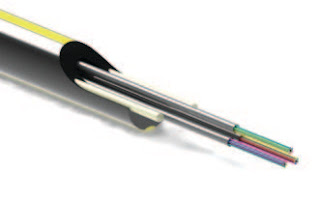 What brought ADSS back down to earth for telcos were a couple of factors: the cost of the cable and its availability. Nearly every ADSS cable has to be pre-engineered per National Electrical Safety Code (NESC) specifications, which created additional lead time and made it difficult for distributors to stock because there wasn't a single product available to fit all applications. Furthermore, the cost of the aramid (Kevlar) in the cable increases your material costs on the project, especially for longer span and higher fiber count applications. In addition to these factors, contractors needed to train and wear special protective equipment to access the power space for installations and maintenance.
What brought ADSS back down to earth for telcos were a couple of factors: the cost of the cable and its availability. Nearly every ADSS cable has to be pre-engineered per National Electrical Safety Code (NESC) specifications, which created additional lead time and made it difficult for distributors to stock because there wasn't a single product available to fit all applications. Furthermore, the cost of the aramid (Kevlar) in the cable increases your material costs on the project, especially for longer span and higher fiber count applications. In addition to these factors, contractors needed to train and wear special protective equipment to access the power space for installations and maintenance.I would like to make some additional clarifications on ADSS, since I have heard some confusion from customers on what the product actually is. As the name implies, "All Dielectric" means that there are no conductive elements in the cable. This is the key to placing within the power space, because the NESC requirements mandate you use a system that is non-conductive. Traditional self-supporting fiber optic or copper cables with a steel messenger or copper conductors do not qualify as all dielectric, so "Figure 8" cables and duct are out.
 So how does the cable self-support without an integrated messenger? There are one of two ways:
So how does the cable self-support without an integrated messenger? There are one of two ways: Fiberglass Reinforced Polymer (FRP) strength members, or Aramid (Kevlar). FRPs are common with service drop or flat drop type cables with lower fiber counts. The Aramid designs are most typically used with long-haul routes, and they offer higher fiber counts. These designs allow for dead end and tangent attachments to be applied directly to the cable sheath. Traditional fiber optic cable designs do not allow for attachments directly to the jacket.
Especially for Aramid cable types, the dielectric materials must be designed to support the cable up to it's Maximum Rated Cable Load (MRCL) and Installation Tension. Fiber counts and cable diameter also factor into application criteria used to calculate a cable design. When you are looking for price and availability on aramid ADSS cable, be prepared to provide the key information required to produce a quote. That information includes:
- Fiber Count and Type
- Maximum Span Distance
- Weather Loading (NESC Light, Medium, Heavy or other)
- Line Voltage (kV) if transmission lines are used
- Installation sag (1.5% typical)
There are still applications for ADSS in telecom networks today, and even more is still being deployed. For some routes, ADSS is your best option. There have been some new products to the market since the boon several years ago, and I would like to highlight those here.
Hubbell Power Systems launched their ADSS hardware line that includes traditional formed wire dead ends, but they also have a couple of products aimed at reducing material costs and installation time.
Hubbell's new ADSS suspension clamps only consist of 2 part numbers that cover spans up to 600 feet with cable diameters ranging from 0.394" to 0.787". Instead of managing multiple SKUs for a build with multiple fiber counts for backbone and laterals, you can count on 2 part numbers at the most for your tangents. This simple design allows for installation in just a few seconds, and it can be bolted or banded to the pole. If a loose tangent is required, you can even mount this clamp with a J-Hook.
In dealing with service cables we often get requests for flat drop cable with more than 12 fibers. The only options were to run multiple 12 count drops, or lash a traditional cable. With the arrival of PPC Broadband's Miniflex ADSS cable, we can offer a round cable with strength members to accomplish this task while still using J-Hook attachments. In a 7mm jacket, PPC can squeeze up to 48 fibers in a dry package that is easy to strip and access. This product enables operators greater flexibility in their access networks to deploy higher fiber counts without the need for surveys, planning and remedial civil works, thereby facilitating rapid and cost effective aerial network deployment. As FTTH and cellular backhaul/fronthaul projects continue to rise in the United States, this cable is worth a look! You can download the data sheet on PPC Miniflex here.
For further information on ADSS and these new products, please contact your Comstar Supply sales representative today.




